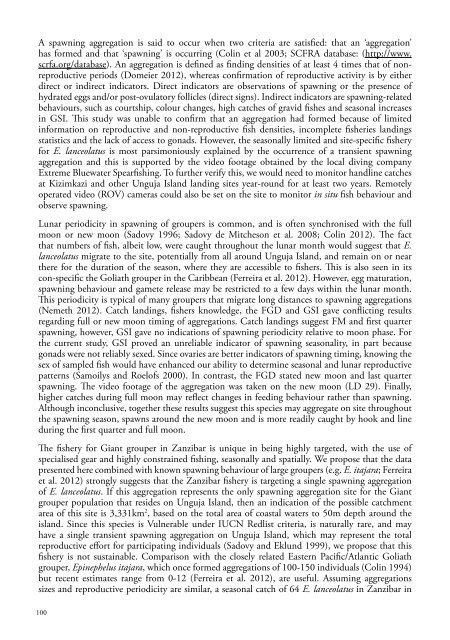WIOMSA-CORDIO spawning book Full Doc 10 oct 13.pdf
WIOMSA-CORDIO spawning book Full Doc 10 oct 13.pdf
WIOMSA-CORDIO spawning book Full Doc 10 oct 13.pdf
Create successful ePaper yourself
Turn your PDF publications into a flip-book with our unique Google optimized e-Paper software.
A <strong>spawning</strong> aggregation is said to occur when two criteria are satisfied: that an ‘aggregation’has formed and that ‘<strong>spawning</strong>’ is occurring (Colin et al 2003; SCFRA database: (http://www.scrfa.org/database). An aggregation is defined as finding densities of at least 4 times that of nonreproductiveperiods (Domeier 2012), whereas confirmation of reproductive activity is by eitherdirect or indirect indicators. Direct indicators are observations of <strong>spawning</strong> or the presence ofhydrated eggs and/or post-ovulatory follicles (direct signs). Indirect indicators are <strong>spawning</strong>-relatedbehaviours, such as courtship, colour changes, high catches of gravid fishes and seasonal increasesin GSI. This study was unable to confirm that an aggregation had formed because of limitedinformation on reproductive and non-reproductive fish densities, incomplete fisheries landingsstatistics and the lack of access to gonads. However, the seasonally limited and site-specific fisheryfor E. lanceolatus is most parsimoniously explained by the occurrence of a transient <strong>spawning</strong>aggregation and this is supported by the video footage obtained by the local diving companyExtreme Bluewater Spearfishing. To further verify this, we would need to monitor handline catchesat Kizimkazi and other Unguja Island landing sites year-round for at least two years. Remotelyoperated video (ROV) cameras could also be set on the site to monitor in situ fish behaviour andobserve <strong>spawning</strong>.Lunar periodicity in <strong>spawning</strong> of groupers is common, and is often synchronised with the fullmoon or new moon (Sadovy 1996; Sadovy de Mitcheson et al. 2008; Colin 2012). The factthat numbers of fish, albeit low, were caught throughout the lunar month would suggest that E.lanceolatus migrate to the site, potentially from all around Unguja Island, and remain on or nearthere for the duration of the season, where they are accessible to fishers. This is also seen in itscon-specific the Goliath grouper in the Caribbean (Ferreira et al. 2012). However, egg maturation,<strong>spawning</strong> behaviour and gamete release may be restricted to a few days within the lunar month.This periodicity is typical of many groupers that migrate long distances to <strong>spawning</strong> aggregations(Nemeth 2012). Catch landings, fishers knowledge, the FGD and GSI gave conflicting resultsregarding full or new moon timing of aggregations. Catch landings suggest FM and first quarter<strong>spawning</strong>, however, GSI gave no indications of <strong>spawning</strong> periodicity relative to moon phase. Forthe current study, GSI proved an unreliable indicator of <strong>spawning</strong> seasonality, in part becausegonads were not reliably sexed. Since ovaries are better indicators of <strong>spawning</strong> timing, knowing thesex of sampled fish would have enhanced our ability to determine seasonal and lunar reproductivepatterns (Samoilys and Roelofs 2000). In contrast, the FGD stated new moon and last quarter<strong>spawning</strong>. The video footage of the aggregation was taken on the new moon (LD 29). Finally,higher catches during full moon may reflect changes in feeding behaviour rather than <strong>spawning</strong>.Although inconclusive, together these results suggest this species may aggregate on site throughoutthe <strong>spawning</strong> season, spawns around the new moon and is more readily caught by hook and lineduring the first quarter and full moon.The fishery for Giant grouper in Zanzibar is unique in being highly targeted, with the use ofspecialised gear and highly constrained fishing, seasonally and spatially. We propose that the datapresented here combined with known <strong>spawning</strong> behaviour of large groupers (e.g. E. itajara; Ferreiraet al. 2012) strongly suggests that the Zanzibar fishery is targeting a single <strong>spawning</strong> aggregationof E. lanceolatus. If this aggregation represents the only <strong>spawning</strong> aggregation site for the Giantgrouper population that resides on Unguja Island, then an indication of the possible catchmentarea of this site is 3,331km 2 , based on the total area of coastal waters to 50m depth around theisland. Since this species is Vulnerable under IUCN Redlist criteria, is naturally rare, and mayhave a single transient <strong>spawning</strong> aggregation on Unguja Island, which may represent the totalreproductive effort for participating individuals (Sadovy and Eklund 1999), we propose that thisfishery is not sustainable. Comparison with the closely related Eastern Pacific/Atlantic Goliathgrouper, Epinephelus itajara, which once formed aggregations of <strong>10</strong>0-150 individuals (Colin 1994)but recent estimates range from 0-12 (Ferreira et al. 2012), are useful. Assuming aggregationssizes and reproductive periodicity are similar, a seasonal catch of 64 E. lanceolatus in Zanzibar in<strong>10</strong>0


















